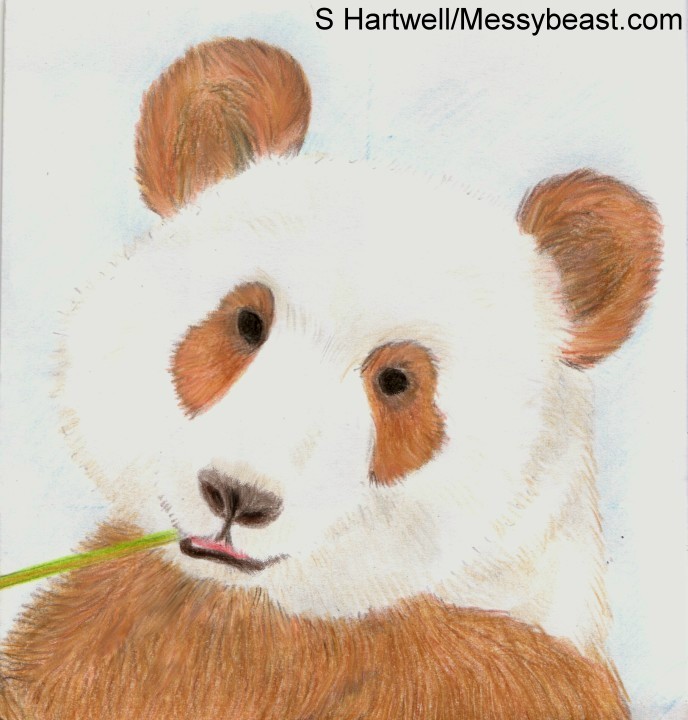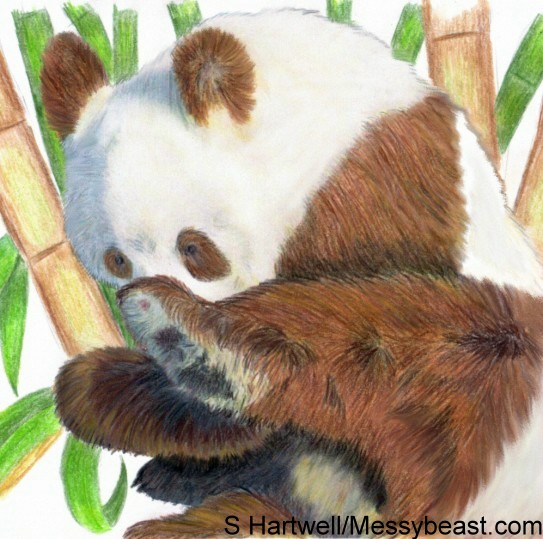
SEPIA GIANT PANDA (BROWN GIANT PANDA)
When asked to describe the endangered Giant Panda (Ailuropoda melanoleuca), most people envisage a black-and-white animal. However, during the 1980s, a brown colour morph of panda was discovered in the Qinling Mountains region of China's Shaanxi Province. It has been dubbed Ailuropoda melanoleuca qinlingensis and may be an emerging subspecies of Giant Panda.

A female "Sepia Panda" (or "Brown Giant Panda") was captured by biologist Pan Wenshi and exhibited at Xi'an Zoo. She was mated to a normal black-and-white Panda and on 31st August 1989, this female, named Dan-Dan, gave birth to a normal black-and-white male cub that the zoo named Bao Bei. According to some reports, four months later, zoo staff noticed that the black areas of Bao Bei's fur was changing colour to brown. According to other reports, Dan-Dan produced three black-and-white cubs, none of which survived to adulthood. Dan-Dan was diagnosed with diagnosed with squamous cell carcinoma in her tail in 2000 and died later that year at the age of 29.
A few years after Dan-Dan was discovered, a second brown-and-white panda was seen in the wild, together with its black-and-white mother. In 1991, a third Brown Giant Panda was discovered and in 2000, a farmer reported seeing a Brown Giant Panda in the Foping National Nature Reserve deep in the Qinling Mountain region. This was the fourth reported Sepia Panda in that region. In 2009, a Brown Giant Panda cub, aged approximately 2 months, was found in the Foping Giant Panda Reserve. Its mother is the more usual black-and-white colour. So far, seven Sepia Pandas have been reported, all from the same region.
The Qinling panda population is small and isolated, a situation that can result in a high degree of inbreeding. Mutant genes can be become widespread in inbred populations. A recessive gene for brown colour could have become established in the Qinling population, becoming visibly noticeable in offspring born to two parents carrying the gene. If Bao Bei did indeed change colour from black to brown, his father would have had to carry the gene as well. It is also possible thatthe gene is not completely recessive and that inheriting a single copy could still influence coat colour to some degree. Although the panda genome has been sequenced, and it would be possible to compare the genomes of normal and sepia forms of giant panda to identify the gene(s) involved, too few brown giant pandas have been studied to be entirely sure of the inheritance mechanism.
Many of Qinling's normal black-and-white pandas are reported to have touches of brown in their chest fur and brownish-white undersides. It is possible that they have one copy of the mutated gene and that it is not fully recessive i.e. not completely masked by the dominant allele for black colour. Alternatively, something in the environment might be affecting pigmentation genes, not just in pandas, but in other animals in the region (it is also home to brown subspecies of other mammals e.g. the golden takin). It has been posited that they are a whole new subspecies of Panda as they have several other differences from other populations of Giant Panda including smaller skulls and larger molar teeth.
|
|
|
Researchers have reported Sepia Panda cubs indicating that they are born brown. So what gene could have caused black fur to turn brown as the animal matures as has been reported for Bao Bei? Qinling's black-and-white pandas also have brown patches in their fur. A black-to-brown colour-change effect has been identified in other mammals including some domestic cat breeds and is caused by the Extension gene (symbol E) or "red factor" which controls the production of red and black pigment. The dominant allele E produces normal black pigment in the coat while the recessive allele e produces red pigment. The Extension gene is responsible for the bay (red-brown body with black extremities) colouration in horses.
Each animal has two versions (alleles) of each of its genes. One version is inherited from the mother and the other is inherited from the father. One of those alleles tends to be dominant (is expressed in the offspring) while the other is recessive (only expressed if the dominant allele is absent). It is possible that Qinling Brown Pandas have the usual dominant allele for the black colour, but at some point in the past, the gene has mutated and produced a recessive allele for the brown colour. Pandas that inherit only one allele from brown fur will look like normal black pandas, but can still pass on the brown allele to their offspring. Pandas that inherit two alleles for brown fur, one from each parent, will have brown fur instead of black. Because recessive genes are normally hidden, the occurrence of brown pandas indicates inbreeding (closely related animals breeding together). So while the new colour is an exciting find, the inbreeding may have adverse effects on the animals' fertility, immune system and health. However genetic analysis of some of Qinling's pandas suggests they are still genetically diverse.

REFERENCES AND FURTHER READING
You are visitor number